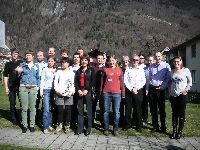IMILAST Workshop in Interlaken
Meeting report
IMILAST (Intercomparison of Mid-latitude Storm Diagnostics) is an international project coordinated by ProClim. It aims at comparing the different identification and tracking algorithms for extratropical storms. At a 3-day workshop (completely sponsored by Swiss Re) from 30 March – 1 April 2011 in Interlaken, Switzerland, 20 experts from all over the world discussed the results from the first method intercomparison calculations.

Storm-associated damages are amongst the highest losses due to natural disasters in the mid-latitudes. Therefore the knowledge of the future variability and change in extratropical cyclone frequency, intensity and track locations is crucial for the strategic planning and minimization of the disaster impacts. The quantification of such trends strongly depends on the methodologies for storm track detection. Thus, scientific studies may find seemingly contradictory results based on the same datasets. This makes the interpretation of storm track analyses and projection results very difficult for any user. In an intercomparison experiment numerous groups using a dozen different tracking methodologies have calculated storm tracks for a pre-defined 20-year period. As input data all calculations used the same ERA-interim reanalysis data set.
At the Interlaken workshop methodological issues with considerable influence on the results were detected and discussed, as e.g. the exclusion of cyclones over high terrain or the inclusion/exclusion of “open” systems (i.e. cyclones without closed pressure contours). First results showed that major differences occur e.g. in cyclone counts and track density, the geographical distribution of tracks, life-time, and track length. However remarkable consistency was found in e.g. trend sign, geographical patterns of trends or the representation of extreme cyclones. Main future steps are, among others, the intercomparison of a set of extreme individual storms and additional analysis to investigate the influence of specific differences between methods. Beside the consolidation of a scientific community of extratropical storm climate, the exchange of knowledge, argumentation, and experience at the workshop will lead – according to feedback of several workshop participants - to an improvement of their algorithms.
Contact
Dr. Urs Neu
SCNAT
ProClim − Forum sur le climat et les changements globaux (ProClim)
Maison des Académies
Case postale
3001 Berne
